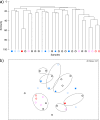Arginine Exposure Decreases Acidogenesis in Long-Term Oral Biofilm Microcosms
- PMID: 28861520
- PMCID: PMC5566835
- DOI: 10.1128/mSphere.00295-17
Arginine Exposure Decreases Acidogenesis in Long-Term Oral Biofilm Microcosms
Abstract
Arginine is an important pH-elevating agent in the oral cavity. It has been incorporated in oral hygiene formulations to mitigate sensitivity and to prevent caries. In this investigation, the effects of sustained arginine dosing of dental plaque microcosms on bacteriological composition and pH were evaluated under controlled conditions. Plaque microcosms were established in constant-depth film fermentors (CDFFs) using salivary inocula and fed continuously with artificial saliva. To simulate resting and cariogenic states, the CDFFs were supplemented with sterile water or 5% sucrose, respectively. Plaques were then dosed twice daily with a dentifrice with 1.5% arginine arginine added (DA) or without arginine (DN). This regimen continued for over 3 weeks, after which fermentors were maintained without dosing. Microcosms were analyzed by differential viable counting, with a pH microelectrode, and by eubacterial DNA profiling. Sucrose dosing was associated with significantly (P < 0.001) decreased pH, significantly (P < 0.05) increased counts of total aerobes, Gram-negative anaerobes, aciduric species, acidogenic species, arginine utilizing species, bifidobacteria, lactobacilli and streptococci, and significant (P < 0.05) changes in DNA profiles. Plaques dosed with DA had a significantly (P < 0.001) higher pH than those dosed with DN, with or without sucrose supplementation. Dosing with DA but not DN significantly (P < 0.05) decreased counts of all functional bacterial groups apart from the total anaerobes in cariogenic plaques, and in resting plaques, dosing with DA significantly (P < 0.05) decreased counts of streptococci, lactobacilli, bifidobacteria, and acidogenic bacteria. In summary, sustained exposure of oral microcosms to arginine in formulation significantly increased plaque pH and significantly reduced the viability of cariogenic bacterial species. IMPORTANCE Arginine is used in dental health formulations to help prevent dental cavities. This study assessed the effects of the long-term dosing of laboratory dental plaques with an arginine dentifrice. Data indicate that the addition of arginine dentifrice during sucrose challenge significantly increased plaque pH, thus potentially mitigating cariogenesis. Counts of several functional groups of bacteria associated with tooth decay were significantly decreased in the laboratory plaques during exposure to the arginine dentifrice.
Keywords: arginine; dental biofilm microcosm; dental plaque.
Figures











Similar articles
-
Caries-related plaque microcosm biofilms developed in microplates.Oral Microbiol Immunol. 2007 Apr;22(2):73-9. doi: 10.1111/j.1399-302X.2007.00323.x. Oral Microbiol Immunol. 2007. PMID: 17311629
-
Bacteriological effects of a Lactobacillus reuteri probiotic on in vitro oral biofilms.Arch Oral Biol. 2011 Nov;56(11):1264-73. doi: 10.1016/j.archoralbio.2011.04.004. Epub 2011 May 13. Arch Oral Biol. 2011. PMID: 21570060
-
Stability and resilience of oral microcosms toward acidification and Candida outgrowth by arginine supplementation.Microb Ecol. 2015 Feb;69(2):422-33. doi: 10.1007/s00248-014-0535-x. Epub 2014 Nov 30. Microb Ecol. 2015. PMID: 25433583
-
[Chewing gum and dental health. Literature review].Rev Belge Med Dent (1984). 1992;47(3):67-92. Rev Belge Med Dent (1984). 1992. PMID: 1305985 Review. French.
-
pH-Responsive Biomaterials for the Treatment of Dental Caries-A Focussed and Critical Review.Pharmaceutics. 2023 Jun 27;15(7):1837. doi: 10.3390/pharmaceutics15071837. Pharmaceutics. 2023. PMID: 37514024 Free PMC article. Review.
Cited by
-
Evaluating models and assessment techniques for understanding oral biofilm complexity.Microbiologyopen. 2023 Aug;12(4):e1377. doi: 10.1002/mbo3.1377. Microbiologyopen. 2023. PMID: 37642488 Free PMC article. Review.
-
AhrC Negatively Regulates Streptococcus mutans Arginine Biosynthesis.Microbiol Spectr. 2022 Aug 31;10(4):e0072122. doi: 10.1128/spectrum.00721-22. Epub 2022 Aug 8. Microbiol Spectr. 2022. PMID: 35938859 Free PMC article.
-
The combined antimicrobial effect of arginine and fluoride toothpaste.Sci Rep. 2019 Jun 10;9(1):8405. doi: 10.1038/s41598-019-44612-6. Sci Rep. 2019. PMID: 31182718 Free PMC article.
-
Effect of a novel synbiotic on Streptococcus mutans.Sci Rep. 2020 May 14;10(1):7951. doi: 10.1038/s41598-020-64956-8. Sci Rep. 2020. PMID: 32409686 Free PMC article.
-
Arginine combination with fluoride and calcium glycerophosphate: effects of concentration and on biofilm fluid.Future Microbiol. 2025 Feb;20(3):201-212. doi: 10.1080/17460913.2024.2411921. Epub 2024 Nov 7. Future Microbiol. 2025. PMID: 39508342
References
-
- Bagramian RA, Garcia-Godoy F, Volpe AR. 2009. The global increase in dental caries. A pending public health crisis. Am J Dent 22:3–8. - PubMed
LinkOut - more resources
Full Text Sources
Other Literature Sources

